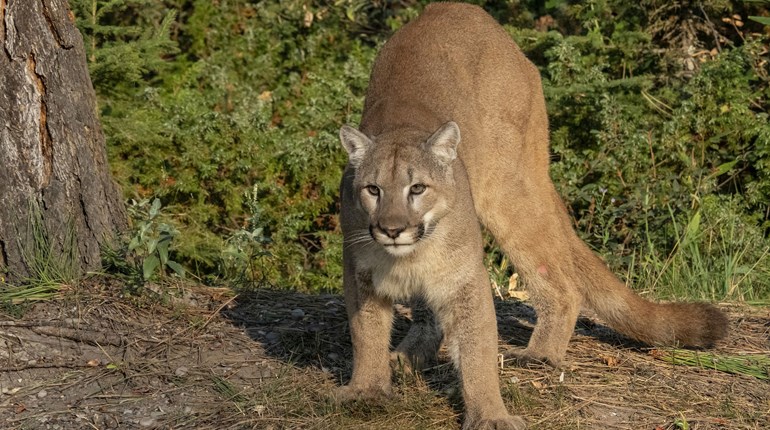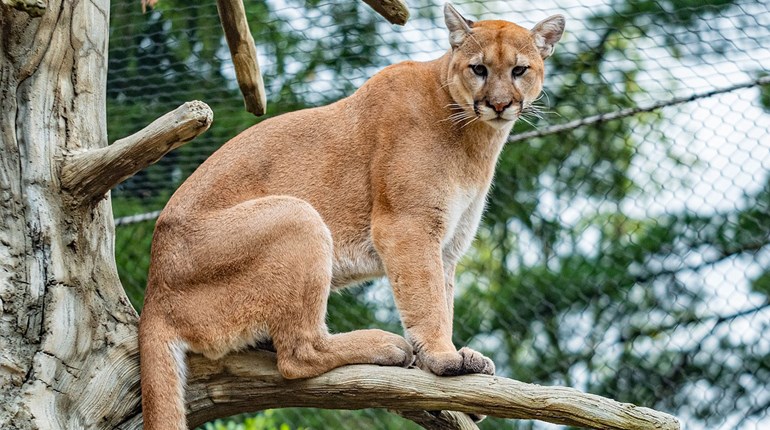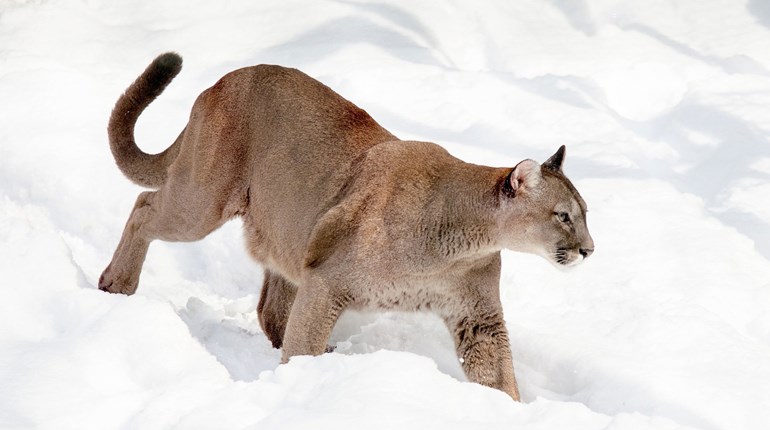
A mountain lion spotted near the eighth green of a Nebraska golf course prompted cancellation of a high-school girls’ tournament. The lion was trapped and killed two days later, but not before it killed a whitetail fawn on the edge of town.
The lion, described as a 103-pound sub-adult, was seen in a cellular trail-camera image and video time-stamped at 10:11 a.m. on Sept. 21, 2023, the morning of the Valentine, Neb., tournament. The school’s athletic director was notified, and the tournament was cancelled. None of the golfers, coaches or anyone else saw the mountain lion on the course, so apparently no one had been in immediate danger. The mountain lion was thought to be the same one reported in Valentine on several earlier occasions.
Two days later a mountain lion, believed to be the same lion spotted on the camera, killed a fawn near a backyard on the edge of town, which prompted Nebraska Game and Parks Commission (NGPC) officials to respond and trap the animal. Working with the Valentine Police Department, NGPC officials decided to dispatch the lion in accordance with NGPC’s Mountain Lion Response Plan, which calls for any mountain lion within a city’s limits to be killed. Relocation of mountain lions is not a viable option because Nebraska does not have suitable public habitat for relocation, according to the NGPC. The majority of the state is privately owned, so any relocated mountain lion would likely roam onto private property, say NGPC officials, and zoos generally do not accept wild mountain lions because they do not adapt well to captivity or proximity to humans.

The tournament, held at the scenic 10-hole Frederick Peak Golf Course on the northeast edge of Valentine, was cancelled about midway through the 18-hole event. Two of the golf course’s holes run along Minnechaduza Creek, which could have served as a natural travel corridor for the lion. Valentine itself is located along the Niobrara River, another likely natural corridor for young lions seeking to expand their range. Surrounding Valentine is ranch and farming country, cut by creeks and canyons and covered in places by pine forest—ideal mountain lion habitat, if it wasn’t for the possibility of encountering humans.
It was believed to be the first time golfing was interrupted by a mountain lion on the course. Previously, golfers have reported seeing mountain lions on or near the golf course, but this was the first confirmed by photographic evidence. Trail cameras are used to monitor the location of golfers and to track wildlife that live near the course, such as deer, turkeys, quail, coyotes and bobcats. Deer trails run along a ridge behind the course in the area where the lion was seen.
Mountain lions can cover hundreds of miles, so this one could have been born locally on the Niobrara or have come from the Black Hills, Rocky Mountains or other areas, according to Sam Wilson, NGPC’s furbearer and carnivore program manager. There is no way to tell the origin of this cat because NGPC wildlife biologists had not marked or tagged the animal in previous research, he said.
“We have populations in three areas—Pine Ridge, Wildcat Hills and Niobrara Valley—and dispersers have been documented over much of the state since the first modern confirmation in 1991,” said Wilson. “We had one collared mountain lion leave the Niobrara Valley and end up in Springfield, Ill.”
Almost all sub-adult male mountain lions disperse from birth areas, likely to ensure genetic health of the species, Wilson explained. Female home ranges can be 62 square miles or more and male home ranges three times as large. “Sub-adult males like this one can walk hundreds or over a thousand miles looking for females and a place to call home,” he said.
 As reported by The Kansas City Star on Sept. 26, 2023, the game camera image was taken near the eighth green of the golf course as a tournament was underway.
As reported by The Kansas City Star on Sept. 26, 2023, the game camera image was taken near the eighth green of the golf course as a tournament was underway.
Mountain lions were historically native to Nebraska but were wiped out in the late 1880s as settlers spread, and they were not seen in the state for approximately 100 years before the first modern confirmation was made in 1991. Since then, mountain lions have naturally reintroduced themselves to the state, walking in from neighboring states with large lion populations such as Wyoming, Colorado and South Dakota.
Nebraska has permitted mountain lion hunting since 2014, usually in the January/February timeframe. For the 2024 season, harvest will be limited to four lions (if two females are killed, the season is over) in the Pine Ridge; and two lions in the Niobrara Unit (one if the first one killed is a female). Once limits are reached, the season is over, no matter how many permits remain. Hunters must check each day prior to hunting to see if the season is still open.
During the initial 2014 season, any lion outside specified northwest hunting units could be hunted and killed, providing the hunter had a $15 Prairie Unit permit. Those permits lasted just that initial season and are no longer available, since mountain-lion hunting came under fire from animal-rights activists and others who picked up support in the state’s one-house legislature, primarily from a senator in Omaha, the largest city in the state, located on the far eastern border. (Ironically, lion sightings were reported in the Omaha area in late July and early August 2023. In one instance on July 24, a doorbell camera captured an image of a mountain lion prowling near homes in southwest Omaha.)
John Heaston, executive director of the Nebraska Sportsmen’s Foundation, said the latest mountain lion-related legislation, to create a depredation reimbursement fund for livestock owners, was lost in partisan bickering over other issues during the last legislative session. “When you have a majority of legislators on (the east) end of the state and they’re looking at mountain-lion depredation and encounter issues from hundreds of miles away, they don’t see it with the same eyes as somebody living in Valentine or Chadron, where there is some frequency of encounters.”
Lion sightings reported near Omaha and Lincoln have “changed that somewhat, but we are still up against an ‘it feels like it can’t be happening here’ mentality,” said Heaston. “There haven’t been any clear and consistent sightings of groups of lions on this end of the state and with everybody and their dog using trail cams and carrying smartphones, if we did have a higher volume of them we would be seeing a lot more video and photographic evidence.” Typically, he explained, mountain lions on the move from their usual haunts are young bachelor males chased out of their family groups and looking for new territory. Therefore, recent sightings have been of lone traveling animals, not family groups taking up residence.





































